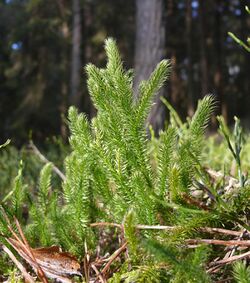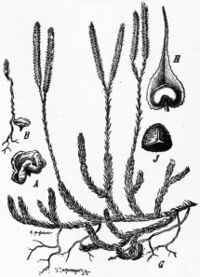Biology:Lycopodium
| Lycopodium | |
|---|---|

| |
| Lycopodium clavatum | |
| Scientific classification | |
| Kingdom: | Plantae |
| Clade: | Tracheophytes |
| Clade: | Lycophytes |
| Class: | Lycopodiopsida |
| Order: | Lycopodiales |
| Family: | Lycopodiaceae |
| Subfamily: | Lycopodioideae |
| Genus: | Lycopodium L.[1] |
| Type species | |
| Lycopodium clavatum | |
| Species | |
|
See text | |
Lycopodium (from Greek lykos, wolf and podion, diminutive of pous, foot)[2] is a genus of clubmosses, also known as ground pines or creeping cedars,[3] in the family Lycopodiaceae. Two very different circumscriptions of the genus are in use. In the Pteridophyte Phylogeny Group classification of 2016 (PPG I), Lycopodium is one of nine genera in the subfamily Lycopodioideae, and has from nine to 15 species.[1][4] In other classifications, the genus is equivalent to the whole of the subfamily, since it includes all of the other genera. More than 40 species are accepted.[5]
Description
They are flowerless, vascular, terrestrial or epiphytic plants, with widely branched, erect, prostrate, or creeping stems, with small, simple, needle-like or scale-like leaves that cover the stem and branches thickly.[6] The stems usually creep along the ground, forking at intervals.[7] The leaves contain a single, unbranched vascular strand, and are microphylls by definition.[6] They are usually arranged in spirals.[7] The kidney-shaped (reniform) spore-cases (sporangia) contain spores of one kind only, (isosporous, homosporous), and are borne on the upper surface of the leaf blade of specialized leaves (sporophylls) arranged in a cone-like strobilus at the end of upright stems.[6] Each sporamgium contains numerous small spores.[7] The club-shaped appearance of these fertile stems gives the clubmosses their common name.
Lycopods reproduce asexually by spores. The plants have an underground sexual phase that produces gametes, and this alternates in the lifecycle with the spore-producing plant. The prothallium developed from the spore is a subterranean mass of tissue of considerable size, and bears both the male and female organs (antheridia and archegonia).[6] They are more commonly distributed vegetatively, though, through above- or below-ground rhizomes.
Taxonomy
The genus Lycopodium was first published by Carl Linnaeus in 1753.[8] He placed it in the Musci (mosses) along with genera such as Sphagnum, and included species such as Lycopodium selaginoides,[9] now placed in the genus Selaginella in a different order from Lycopodium. Different sources use substantially different circumscriptions of the genus. Traditionally, Lycopodium was considered to be the only extant genus in the family Lycopodiaceae, so includes all the species in the family, although sometimes excluding one placed in the monotypic genus Phylloglossum.[10] Other sources divide Lycopodiaceae species into three broadly defined genera, Lycopodium, Huperzia (including Phylloglossum) and Lycopodiella. In this approach, Lycopodium sensu lato has about 40 species.[11][5] In the Pteridophyte Phylogeny Group classification of 2016 (PPG I), the broadly defined genus is equivalent to the subfamily Lycopodioideae, and Lycopodium is one of 16 genera in the family Lycopodiaceae, with between 9 and 15 species.[1][4]
| Traditional[10] | Christenhusz & Chase (2014)[11] | PPG I[4] |
|---|---|---|
| Lycopodium + Phylloglossum |
Lycopodium s.l. | Lycopodium s.s. + 8 other genera making up subfamily Lycopodioideae |
| Two other genera | 7 genera (including Phylloglossum) in two subfamilies |
Species

Using the narrow circumscription of Lycopodium, in which it is one of nine genera in the subfamily Lycopodioideae, the Checklist of Ferns and Lycophytes of the World recognized the following species (As of January 2023):[1]
- Lycopodium clavatum L. – stag's-horn clubmoss; subcosmopolitan
- Lycopodium diaphanum (P.Beauv.) Sw. – Tristan da Cunha
- Lycopodium japonicum Thunb. – eastern Asia (Japan west and south to India and Sri Lanka)
- Lycopodium lagopus (Laest. ex C.Hartm.) Zinserl. ex Kuzen. – circumpolar arctic and subarctic
- Lycopodium papuanum Nessel – New Guinea
- Lycopodium venustulum Gaudich. – Hawaii, Western Samoa, the Society Islands
- Lycopodium vestitum Desv. ex Poir. – northwest South America (Andes)
Uses
The spores of Lycopodium species are harvested and are sold as lycopodium powder.
Lycopodium sp. herb has been used in the traditional Austrian medicine internally as tea or externally as compresses for treatment of disorders of the locomotor system, skin, liver and bile, kidneys and urinary tract, infections, rheumatism, and gout,[12] though claims of efficacy are unproven. It has also been used in some United States government chemical warfare test programs such as Operation Dew.[13] Lycopodium powder was also used to determine the molecular size of oleic acid.[citation needed]
References
- ↑ 1.0 1.1 1.2 1.3 Hassler, Michael (19 January 2023), "Lycopodium", World Ferns. Synonymic Checklist and Distribution of Ferns and Lycophytes of the World, 14.7, https://www.worldplants.de/ferns/, retrieved 2023-01-22
- ↑ λύκος, πούς. Liddell, Henry George; Scott, Robert; A Greek–English Lexicon at the Perseus Project.
- ↑ The Columbia Encyclopedia, Sixth Edition, 2008
- ↑ 4.0 4.1 4.2 PPG I (2016), "A community-derived classification for extant lycophytes and ferns", Journal of Systematics and Evolution 54 (6): 563–603, doi:10.1111/jse.12229
- ↑ 5.0 5.1 "Lycopodium L.". Plants of the World Online. Royal Botanic Gardens, Kew. https://powo.science.kew.org/taxon/urn:lsid:ipni.org:names:30000138-2.
- ↑ 6.0 6.1 6.2 6.3 Cite error: Invalid
<ref>tag; no text was provided for refs namedEB1911 - ↑ 7.0 7.1 7.2 Levyns, M.R. (1966). A Guide to the Flora of the Cape Peninsula (2nd Revised ed.). Juta & Company, Limited. OCLC 621340.
- ↑ "Lycopodium L.". The International Plant Names Index. https://www.ipni.org/n/30000138-2.
- ↑ Linnaeus, C. (1753), "Lycopodium", Species Plantarum, II, pp. 1100ff, https://biodiversitylibrary.org/page/359121, retrieved 2019-12-21
- ↑ 10.0 10.1 Sporne, K.R. (1966), The Morphology of Pteridophytes (2nd ed.), London: Hutchinson, chap. 4, OCLC 253704767
- ↑ 11.0 11.1 Christenhusz, Maarten J.M.; Chase, Mark W. (2014). "Trends and concepts in fern classification". Annals of Botany 113 (9): 571–594. doi:10.1093/aob/mct299. PMID 24532607.
- ↑ Vogl, S; Picker, P; Mihaly-Bison, J; Fakhrudin, N; Atanasov, A. G.; Heiss, E. H.; Wawrosch, C; Reznicek, G et al. (2013). "Ethnopharmacological in vitro studies on Austria's folk medicine—an unexplored lore in vitro anti-inflammatory activities of 71 Austrian traditional herbal drugs". Journal of Ethnopharmacology 149 (3): 750–71. doi:10.1016/j.jep.2013.06.007. PMID 23770053.
- ↑ U.S. National Research Council, Subcommittee on Zinc Cadmium Sulfide. Toxicologic Assessment of the Army's Zinc Cadmium Sulfide Dispersion, National Academies Press, 1997, pp. 44–77, ISBN:0309057833.
<ref> tag with name "EB1911" defined in <references> group "" has no content.External links
- Species list (takes a broad view of the genus, including the species here separated in the genus Diphasiastrum)
- Burning Lycopodium Powder: Simulating a Grain Elevator Explosion by Kevin A. Boudreaux
Wikidata ☰ Q624488 entry
 |

